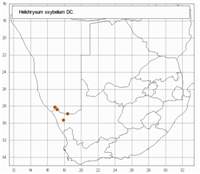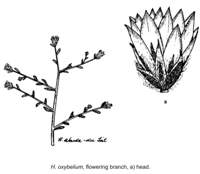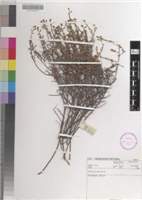Origin of name:
oxy- = sharp, sour, pointed
Diagnostic characters:
Delicate plantsYoung leaves very woolly but soon shedding the hairs to expose very dense glandsSmall solitary headsStraw-coloured bracts, tinged pink
Description:
Rounded, stiff, twiggy, divaricately branched shrublet up to 300 mm tall, old twigs bare, reddish brown, subspinescent, young twigs glandular-pubescent, distantly leafy. Leaves 4-10 x 0.75-1 mm, linear, sessile, acute, apiculate, hooked, margins revolute, both surfaces thickly and loosely greyish-white woolly when very young, later only glandular-pubescent with some woolly hairs clinging particularly in the leaf axils and on the lower surface. Heads heterogamous, c. 4.5 x 3 mm, turbinate-campanulate, solitary at the tips of the twigs, surrounded by reduced leaves. Involucral bracts in 4-6 series, outermost short, glandular-pubescent below, thinly woolly, inner subequal, lanceolate, acuminate, about equaling flowers, erect, pellucid, glossy, purplish, tips golden-brown. Receptacle flat, honeycombed. Flowers 19-29, 7-13 female, 11-16 homogamous. Achenes not seen, ovaries with myxogenic duplex hairs. Pappus bristles many, equaling corolla, scabrid, bases nude, not cohering.
Flowers in September and October.
Distribution:
Grows in 'Namaqualand Broken Veld of low granite domes' fide Acocks. Recorded from Grootklip in Vanrhynsdorp district and Kamiesberg, Steinkopf, Ratelpoort Mountain, Corkscrew Mountain and the mouth of the Orange River in Namaqualand.
Nama Karoo and Succulent Karoo Biomes.
Notes:
H. oxybelium is often confused with some forms of H. asperum sens. lat., but is most readily distinguished by its heterogamous heads containing more flowers than the homogamous heads of H. asperum.
A specimen collected by Nordenstam in the Richtersveld differs from typical H. oxybelium in its lack of stalked glands, persistently woolly leaves with scarcely revolute margins and obtuse rather than very acute involucral bracts (Richtersveld, Granite Boss, S. of Kuboes, W. slope, granite rocks and coarse sand, 5 xi 1962, Nordenstam 1778, E; S). However, H. oxybelium is known from so few collections that I hesitate to give formal recognition to this variant.
Taxonomy:
Literature:
Helichrysum oxybelium DC., Prodr. 6: 171 (1838); Harv. in F.C. 3: 216 (1865); Moeser in Bot. Jb. 44: 299 (1910).
Type:
Lectotype: Cape, Namaqualand, Kamiesberg, Boschmanland and mouth of the Gariep, Ecklon 1670 (G-DC.).
Synonym(s):
Gnaphalium oxybelium (DC.) Sch. Bip. in Bot. Ztg 3: 169 (1845).
Vouchers:
Acocks 19059 (PRE); Pearson 2967 (K) and 5734 (BOL; K); Schlechter 11483 (PRE); Schlechter 11482 (BOL).

